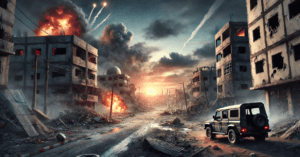U.S. Pushes for Gaza Ceasefire with Hostage Deal, but Time Running Out
The U.S. government says a “bridge proposal” is still available to extend the Gaza ceasefire, but time is running out. The plan includes releasing five hostages, including American Edan Alexander, in exchange for Palestinian prisoners held by Israel.
Despite this, violence has escalated. Israeli forces have resumed ground attacks, with airstrikes killing at least 48 Palestinians. A day earlier, over 400 were killed in one of the deadliest strikes since the war began in October 2023.
The conflict started when Hamas attacked Israel on October 7, 2023, killing 1,200 and taking 250 hostages. In response, Israel’s military operations have killed over 49,000 Palestinians, displaced nearly all of Gaza’s 2.3 million people, and caused a hunger crisis.
The U.S. calls the proposal “compelling” and supports Israel but warns the ceasefire opportunity is fading fast.
CONTENT:

U.S. Pushes for Gaza Ceasefire with Hostage Deal, but Time Running Out
The United States has introduced a temporary peace plan to extend the ceasefire in Gaza, but officials warn that time is running out to reach an agreement. The proposal includes the release of five hostages held by Hamas, including 19-year-old American Edan Alexander, in exchange for Israel freeing a significant number of Palestinian prisoners. Despite hopes for a deal, violence has intensified in recent days, with Israeli forces expanding ground operations and carrying out airstrikes that killed at least 48 Palestinians within 24 hours. This followed an even deadlier attack the previous day, which claimed over 400 Palestinian lives—one of the bloodiest days since the war began in October 2023.
Background: How the Conflict Began
The war erupted on October 7, 2023, when Hamas militants launched a surprise attack on southern Israel, killing approximately 1,200 people and taking around 250 hostages. In response, Israel initiated intense air and ground assaults on Gaza, aiming to dismantle Hamas and secure the release of hostages. However, the offensive has led to severe humanitarian consequences. According to Palestinian health officials, more than 49,000 Gazans have been killed, though Israel disputes these figures. Nearly all of Gaza’s 2.3 million residents have been displaced, with many forced to live in overcrowded shelters or makeshift tents. Supplies of food, water, and medicine are critically low, and the United Nations has warned of widespread starvation.
Ceasefire Efforts and Challenges
The U.S.-backed ceasefire proposal, described by the State Department as “compelling,” seeks to pause fighting long enough to allow hostage releases and aid deliveries. A previous short-term truce in November 2023 resulted in Hamas freeing over 100 hostages in exchange for Israel releasing Palestinian prisoners. However, negotiations have repeatedly stalled, with both sides blaming each other for the lack of progress. Hamas insists that any agreement must include a permanent end to the war and a full Israeli withdrawal from Gaza. Meanwhile, Israel refuses to halt military operations until Hamas is neutralized and all hostages are returned.
Growing Humanitarian Crisis
Civilians in Gaza continue to face extreme hardship. Hospitals, overwhelmed by casualties and medical shortages, are struggling to function. Parents describe scouring markets for scraps of food to feed their children, while some have resorted to eating animal feed. The World Food Program reports that 93% of Gaza’s population is experiencing crisis-level hunger. International aid groups accuse Israel of blocking adequate humanitarian assistance from entering the territory—an allegation Israel denies, stating that it facilitates deliveries but blames Hamas for diverting supplies.
International Reactions
While the U.S. continues to support Israel’s right to self-defense, it has also become increasingly critical of the high civilian death toll. Although urging Israel to exercise greater precision, the Biden administration has vetoed U.N. resolutions calling for an immediate ceasefire. Meanwhile, South Africa has accused Israel of genocide at the International Court of Justice, citing mass displacement and starvation among Palestinians. Israel strongly rejects these allegations, calling them a “distortion” of reality and arguing that Hamas uses civilians as human shields.
What’s Next?
With the latest proposal on the table, U.S. officials stress that the opportunity for a ceasefire is “rapidly fading.” Families of hostages, including Edan Alexander’s, continue to plead for a deal to bring their loved ones home. Yet, as violence escalates, hopes for a breakthrough are dimming.
For Gazans, each day brings more loss. “We’re not just numbers,” said one survivor after an airstrike destroyed his neighborhood. “We’re human beings clinging to life.”
As global pressure mounts for a resolution, the stakes couldn’t be higher. Without a breakthrough, the cycle of violence and suffering is likely to deepen, leaving countless lives hanging in the balance.
Overnight Israeli Strikes Kill 71 in Gaza as Violence Escalates
Overnight Israeli airstrikes in northern and southern Gaza killed at least 71 Palestinians, including women and children, according to Al Jazeera’s correspondent. This follows a surge in violence after the collapse of a ceasefire earlier this week.
Gaza’s Health Ministry reports that approximately 436 Palestinians, including 183 children, have died since Israel resumed military operations on Tuesday. As Israeli ground forces expand their offensive, Prime Minister Benjamin Netanyahu has warned of escalating clashes, including potential intensification in the occupied West Bank alongside the ongoing war with Hamas.
The Health Ministry states that more than 49,500 Palestinians have been killed and 112,700 injured since the conflict began. However, Gaza’s Government Media Office estimates the death toll exceeds 61,700, citing thousands still trapped under rubble from bombings.
In Israel, Hamas’s October 7, 2023, attacks resulted in 1,139 deaths and the capture of over 200 hostages, marking the start of the current war.
You must be logged in to post a comment.